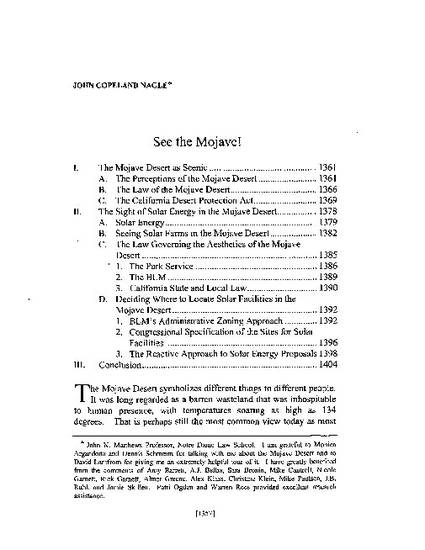
This article examines how the law is being asked to adjudicate disputed sights in the context of the Mojave Desert. The Mojave is the best known and most explored desert in the United States. For many people, though, the Mojave is missing from any list of America’s scenic wonders. The evolution in thinking about the Mojave’s aesthetics takes places in two acts. In the first act, covering the period from the nineteenth century to 1994, what began as a curious voice praising the desert’s scenery developed into a powerful movement that prompted Congress to enact the CDPA. The second act begins around 2005, when the nation’s energy policy again turned to the potential of renewable energy. The Mojave is an obvious sight for large-scale solar energy development, but that supposedly green technology threatens many of the scenic values that Congress decided to protect in the CDPA.
The common theme that runs through this article is that the law needs to develop better ways to address the importance of visual perception of both natural and cultural sights. The sights of the Mojave Desert elicit different reactions from different people. Each of these reactions is both strongly held and reasonable, which challenges the law’s ability to accommodate them. The experience with desert preservation and the proposed solar facilities shows that the law needs to find a way to respect contrasting perceptions of the same things. Sometimes this can be achieved by putting the right thing in the right place. Often, though, the same sight that some people treasure is a sight that others find offensive. In such cases, we should prefer decision-making processes that solicit public involvement that first identifies those contrasting perceptions and then seeks to honor them. The role of public input is especially critical on government property, which characterizes most of the Mojave Desert. Congress has intervened to insure the appropriate response to the conflicting public perceptions for each of the three contested Mojave Desert sights. That congressional action and the attendant place-based lawmaking offer the best hope of honoring the contrasting perceptions of the sights of the Mojave.
Available at: http://works.bepress.com/john_nagle/44/

Reprinted with permission of Oregon Law Review.